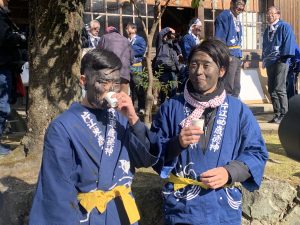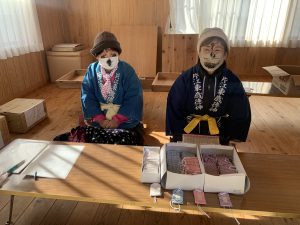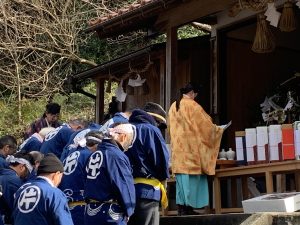Mihonoseki – The Black Ink Festival, or Sumitsuke Tondo, fully returned to the Katae Fishing Hamlet in the Shimane Peninsula on January 7th. This marked the first full-scale local Shinto rites since 2020, drawing a larger crowd than in the previous three years. Many sightseers, including camerapeople, flocked to the Shimane fishing hamlet, renowned for its coastal fishing known as the Katae Fishing Flotilla.

The small hail hit Katae, but it became clear around 11:30 when the locals gathered at the time-honoured Katae Shrine. Dedicated to Kunioshiwake wa Kami, associated with good harvest and fishing, the shrine, believed to have been built before the 18th century, boasts a bright wooden main structure and moss stone-made walls under the shadow of a hill.
The Katae inhabitants and sightseers were painted with black inks ー made from a mixture of charcoal and alcohol ー on their faces. The local legend says that those who are painted with black ink on their faces could avoid getting infected with sickness and maritime accidents. They also drank sacred sake called omiki.

At noon, on declaring the commencement of the Shinto ritual, two female Shinto priests adorned in orange-upper garments and light blue pleated skirts prayed with their holly mezzo-soprano Shinto prayer to ask the god to descend. Meanwhile, their parishioners, or ujiko, wearing blue happi coats engraved in the hamlet’s maru-kata kanji emblems on their backs, downed their heads to pay homage to the guardian deity. Springs of the sacred sakaki three were offered by the two head parishioners, or oyato, and the priests in front of two portable shrines, like the kami’s rickshaws.

After the solemn departing ceremony, the two portable shrines took off vigorously from the shrine’s precincts, with the carriers shouting, ‘cho-sa-da, cho-sa-da’. A group of female ujiko followed the portable shrines while offering holy sake and snacks to the sightseers.

The hallowed kami’s rickshaws paraded west of the Katae Fishing Hamlet, then took a short break at an open space where two bamboo towers called tondo were temporally erected. The pillars fluttering the ensigns of the glorious Katae Fishin Flotilla used, due to being blown by the 7-meter east wind, proudly stood out as landmarks of the Katae Fishing Hamlet.
‘The ending of the coronavirus restriction has brought an expansion of our vision. This is awesome, great’, said Yuji Aoto, a bearer and the proprietor of the guest house Kataean.
After the break, the portable shrine headed for the fishing market, which is crucial for the local fishermen so as to support the Katae’s economy. The morale of the ujiko reached peaks.
Only then did the portable shrines return from the east area to a beach for purification by soaking in seawater. As the highlight of the festival, oyato, just-married husbands, and media reporters were cast into the sea, which was very cold.
The Katae Fishing Hamlet is sandwiched between the Miyano mountains and the Japan Sea coastline. The ancient local historical record, the Izumo Fudoki, says the Japanese god Kunioshiwake named the land Katae. About 500 residents live in the hamlet.
The village is located in a remote area of the Shimane Peninsula, three hours by public transport from Tokyo (Haneda Airport). It takes 1.5 hours from Haneda Airport to Yonago Airport, then 20 minutes by JR Sakaiminato line or bus to Sakaiminato Station. Visitors should transfer to the Mihonoseki Community Bus bound for Ui Ferry Landing Stage for 10 minutes, then take a 15-minute bus ride to Katae Chuo.
(Words by Takashi Saito)
Helpful Link(About the festival)
Japan Endless Discovery (JNTO)
How to get to Katae(a part of Mihonoseki)
(Another route)
From JR Okayama Station on the Sanyo Shinkansen, take the Yakumo limited express to JR Matsue Station (2 hours and a half), then board the Ichibata Bus bound for Mihonoseki Bus Terminal (45 minutes). Transfer to the Mihonoseki Community Bus Shichirui Line and get off at the ‘Katae Chuo’ bus stop (12 minutes). Katae Shrine is 5 minutes on foot from the bus stop.
721 Katae, Mihonoseki-cho, Matsue-shi, Shimane-Prefecture

